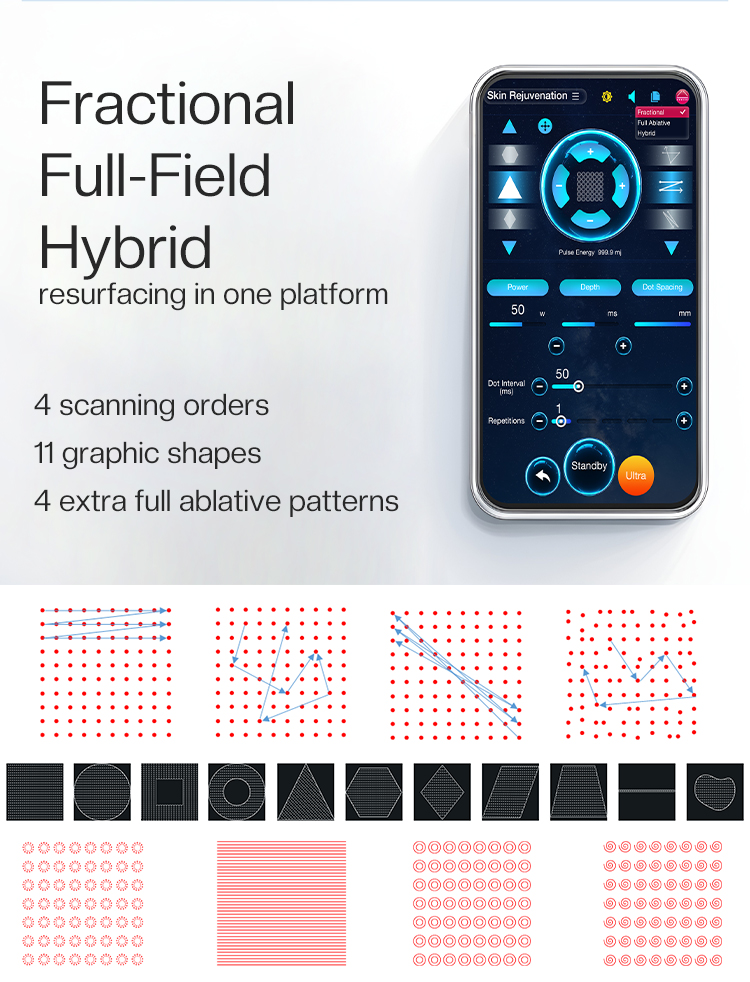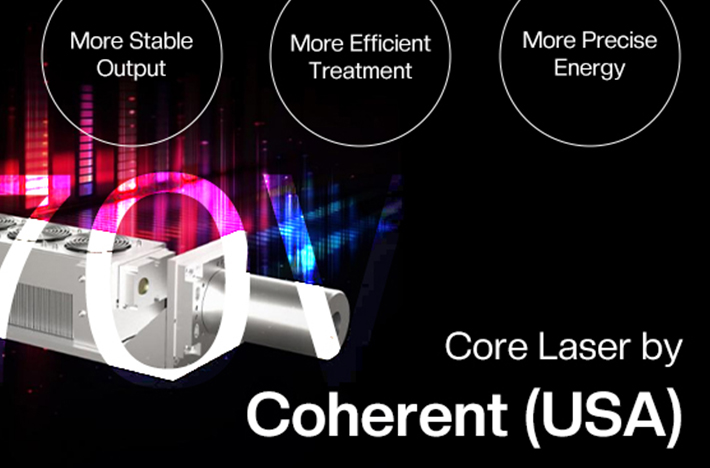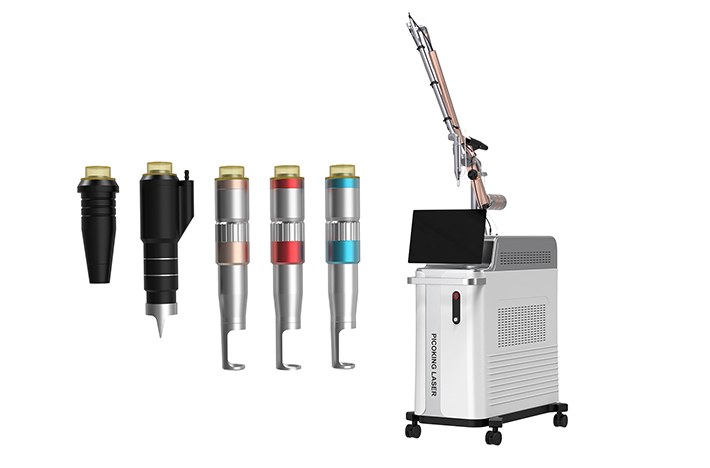Revolutionising Acne Scar Treatment: The Unmatched Efficacy of Fractional CO₂ Laser Technology
Understanding the Fractional CO₂ Laser Skin Resurfacing Machine
At its core, a Fractional CO₂ Laser Skin Resurfacing Machine is a sophisticated medical device that utilises a laser beam with a wavelength of 10,600 nanometres. This wavelength is exceptionally well-absorbed by the water content in skin cells, making it highly effective for precise ablation and heating of dermal tissue. The revolutionary aspect of this technology lies in its “fractional” methodology. Unlike older, fully ablative lasers that treated the entire skin surface in a continuous manner—leading to prolonged recovery and higher risks—the fractional approach delivers the laser energy in a pixelated pattern. This creates countless microscopic treatment zones (MTZs), or “islands” of controlled thermal injury, while leaving the surrounding tissue completely intact.
This strategic micro-perforation is the key to its success. The body’s innate healing mechanisms are immediately activated. Fibroblasts—the cells responsible for producing collagen and elastin—are stimulated within these microscopic channels. This process, known as neocollagenesis and elastogenesis, gradually remodels the dermal structure from the inside out, filling in scars and improving overall skin firmness and elasticity.

Modern devices, such as Winkonlaser’s FraxCO₂, exemplify this technological evolution by integrating three distinct operational modes:
-
Fractional Mode: Ideal for general scar treatment and skin rejuvenation, creating a grid of micro-injuries.
-
Fully Ablative Mode: Used for more aggressive surface-level treatments or specific lesions.
-
Hybrid Mode: A versatile setting that combines both fractional and ablative actions, perfect for treating mixed scar types or sensitive areas with enhanced safety.
These machines offer remarkable precision, with adjustable microbeam diameters ranging from a ultra-fine 0.12 mm to a more substantial 2 mm, and scanning areas up to 20×20 mm. This ensures uniform energy delivery, eliminating “hot spots” and ensuring consistent, predictable results across the treatment area. For the professional, this translates into a powerful, adaptable tool that enhances clinic efficiency, shortens procedure times, and significantly boosts patient satisfaction.
Key Components for Comprehensive Treatment
A high-quality Fractional CO₂ Laser system is comprised of several specialised components, each designed for a specific therapeutic purpose:
-
The Resurfacing Scanner: This is the primary handpiece, responsible for creating the precise grid of micro-perforations during fractional treatments. It is the workhorse for scar revision and skin resurfacing.
-
The Cutter Handpiece: Offering surgical precision, this attachment is designed for the focused excision of localized skin defects, fibromas, or other benign lesions.
-
The Vaginal Probe: This component expands the machine’s utility beyond dermatology into the field of intimate health, facilitating treatments for vaginal rejuvenation and mild stress urinary incontinence.
These handpieces are typically integrated via a 360-degree rotating articulated arm, providing unparalleled access to difficult-to-reach anatomical contours with minimal patient discomfort.
Why Atrophic Acne Scars Require a Targeted Strategy
To appreciate the efficacy of the Fractional CO₂ laser, one must first understand the nature of atrophic acne scars. These scars are not surface stains but are instead depressions caused by the destruction of collagen and subcutaneous fat during the severe inflammatory phase of acne. As the skin heals from a deep cyst or nodule, it fails to regenerate sufficient structural tissue, leading to a loss of support and a characteristic “pitting” or “rolling” appearance.
The ECCA (Échelle d’évaluation clinique des cicatrices d’acné) scale is a standardised tool used by clinicians to classify these scars based on their type, depth, and quantitative extent. This detailed assessment is crucial, as it directly informs the laser parameters—such as energy density, microbeam size, and treatment density—required for an optimal outcome. The primary goal of treatment is to aggressively stimulate dermal fibroblasts, prompting a robust synthesis of new collagen that will incrementally elevate the scarred depressions. Clinical studies have demonstrated that a successful series of Fractional CO₂ laser treatments can increase dermal density by an impressive 20-30%.
A Detailed Look at Scar Types and Laser Efficacy

Treating these varied scar types necessitates precise calibration. The density of the microscopic treatment zones (MTZ/cm²) is carefully tuned, typically ranging from 100 to 300 MTZ/cm², to ensure a powerful therapeutic effect without overloading the skin and compromising its healing capacity.

The Multifaceted Advantages of Fractional CO₂ Laser Technology
The superiority of the Fractional CO₂ Laser Machine in acne scar treatment is rooted in its advanced engineering and versatile application.
-
Unmatched Speed and Precision: Equipped with intelligent digital drivers and automated scanning patterns, these devices distribute laser energy evenly and efficiently, operating 2 to 3 times faster than older random-spot scanning systems. This speed reduces procedure time and, consequently, patient discomfort. Furthermore, features like auto-manipula recognition and multi-level fault protection ensure consistent and safe operation.
-
Enhanced Safety Profile: The fractional method and ultra-pulse technology (a feature of advanced 2025 models like the new Winkonlaser CO₂ fractional laser machine) confine thermal damage to precise micro-columns. This drastically reduces the risk of side effects like prolonged erythema (redness) and post-inflammatory hyperpigmentation (PIH), especially when compared to traditional ablative lasers. The controlled heat allows for safer treatment on a wider range of skin phototypes.
-
Rapid Recovery and Remarkable Results: The ultra-pulse mode enables incredibly brief, high-energy pulses that vaporise tissue with minimal residual heat. This precision translates to a significantly shortened downtime—typically just 3 to 5 days of social downtime, as opposed to the weeks required by older technologies. Patients can typically expect a 50-70% improvement in skin texture and scar appearance after a series of 3 to 5 sessions.
-
Exceptional Versatility: A single machine platform can be used for over a dozen procedure categories. Beyond being a premier acne scar removal machine, it is effective for wrinkle reduction, skin tightening, treatment of other scar types, benign lesion removal, and even intimate rejuvenation procedures.
The data supporting these claims is compelling. Studies indicate a collagen boost of up to 150% in the initial months following treatment, laying the foundation for long-term skin quality improvement that continues to evolve for up to a year.
A Step-by-Step Guide to the Treatment Journey
Undergoing a Fractional CO₂ laser treatment is a structured process designed for maximum safety and efficacy.
-
Comprehensive Consultation and Preparation: The journey begins with a detailed assessment where the practitioner evaluates the patient’s scars using the ECCA scale and determines the optimal laser parameters. Pre-treatment preparation involves thoroughly cleansing the skin and applying a topical anaesthetic cream (e.g., lidocaine) for 30-45 minutes to ensure comfort.
-
Precision Machine Setup: Based on the consultation, the practitioner selects the appropriate mode (e.g., fractional for deep icepick scars, hybrid for rolling scars) and sets the parameters, including energy level and density (often between 150-250 MTZ/cm²).
-
The Laser Application: The practitioner uses the scanner handpiece to treat the skin in systematic passes over the 20×20 mm zones. The laser emits a rapid series of pulses, creating the grid of micro-channels. The entire procedure for a localised area typically takes between 15 to 30 minutes.
-
Immediate Post-Treatment Care: Immediately after the session, a soothing cream and a high-SPF sunscreen are applied. The patient can leave the clinic shortly thereafter. The skin will appear red and feel sensitive, similar to a moderate sunburn.
-
The Recovery and Results Timeline: The initial redness and swelling subside within a few days, followed by a period of slight peeling and bronzing as the microscopic treated tissue exfoliates. With advanced devices like the FraxCO₂, recovery is notably swift. The full treatment course usually involves 3 to 6 sessions, spaced 4 to 6 weeks apart. While some improvement is visible after the first session, the most dramatic results—driven by ongoing collagen remodelling—peak between 3 to 6 months after the final treatment.
Winkonlaser: A Leader in Aesthetic Medical Technology
Founded in 2012 in Beijing, China, Winkonlaser has established itself over 12 years as a globally recognised and trusted manufacturer of professional aesthetic and medical laser equipment. With a diverse portfolio of over 50 different models, their products are exported to and utilised in more than 120 countries, a testament to their reliability and performance.
The company’s commitment to quality and safety is underscored by its possession of international certifications, including ISO 9001, FDA clearance, and the Medical CE mark. Winkonlaser invests heavily in research and development, operating independent R&D labs to drive innovation. Their flagship platforms, such as the FraxCO₂, are equipped with user-friendly Android AI interfaces that support over 12 languages and offer Over-The-Air (OTA) update capabilities, ensuring machines remain at the cutting edge.
To guarantee prompt global service, Winkonlaser maintains strategic warehouses in the United States, France, and Turkey. Their mission consistently focuses on delivering cost-effective, high-performance solutions for skin rejuvenation and dermatological challenges, always prioritising patient safety and clinical efficacy. More information can be found on the Winkonlaser official website.
Frequently Asked Questions (FAQ)
1. How does a Fractional CO₂ Laser Machine specifically work on acne scars?
The machine works by creating thousands of microscopic thermal zones in the dermis. This controlled injury initiates the body’s natural wound-healing process, which is dominated by the production of new collagen and elastin. This new tissue effectively fills in the atrophic scars from below while the fractional approach ensures the surrounding healthy skin facilitates rapid healing, leading to smoother skin texture without the need for complete epidermal removal.
2. How many treatment sessions are typically needed to see significant results?
For moderate to severe atrophic acne scarring, a series of 3 to 5 sessions is generally recommended. These are spaced 4 to 6 weeks apart to allow the skin to fully heal and the collagen to remodel between treatments. The final results are cumulative and continue to improve, typically peaking around 3 to 6 months after the final session as collagen production reaches its zenith.
3. What are the potential side effects, and how are they managed?
Temporary side effects are common and include redness, swelling, and a sensation similar to sunburn, which usually resolve within 24-72 hours. This is followed by peeling and a slight bronzing of the skin for 3-7 days as the microscopic treated tissue sheds. Serious risks like infection or hyperpigmentation are minimal when the procedure is performed by a trained professional with correct settings. Strict sun avoidance and the use of recommended moisturisers and sunscreens are critical during the recovery phase.
4. Is this treatment suitable for all skin types and tones?
While Fractional CO₂ lasers are suitable for a broad range of skin types, extra caution is required for individuals with darker skin phototypes (Fitzpatrick IV-VI). The laser’s energy can sometimes overstimulate melanocytes, leading to temporary hyperpigmentation. To mitigate this risk, practitioners use lower energy densities and adjusted parameters. A thorough consultation with a qualified dermatologist is essential to assess suitability and customise a safe treatment plan.
5. How can I maintain the results long-term after completing my treatments?
Maintaining results requires a diligent skincare regimen. Daily use of a broad-spectrum sunscreen with SPF 50 or higher is non-negotiable to protect the newly formed collagen and prevent UV-induced damage. Keeping the skin well-hydrated and avoiding any form of skin trauma, including picking or excessive manual exfoliation, is crucial. Many patients opt for a single annual maintenance or “touch-up” session to perpetuate the rejuvenated appearance.
Ready to embark on your journey to smoother, more confident skin? The path to banishing acne scars for good begins with a consultation. Reach out to a certified dermatologist or aesthetic specialist today to explore a personalised treatment plan utilising the transformative power of advanced Fractional CO₂ Laser Machines. Your renewed confidence and radiant skin await—take that pivotal first step now!













Leave a Reply
You must be logged in to post a comment.